Scuderia Ferrari
 | |
| Full name | Scuderia Ferrari |
|---|---|
| Base | Maranello, Italy |
| Team principal(s) | Maurizio Arrivabene |
| Technical director(s) | James Allison |
| Founder(s) | Enzo Ferrari |
| Website |
formula1 |
| 2015 Formula One season | |
| Race drivers |
5. 7. |
| Test drivers |
|
| Chassis | SF15-T |
| Engine | Ferrari |
| Tyres | Pirelli |
| Formula One World Championship career | |
| Debut | 1950 Monaco Grand Prix |
| Latest race | 2015 Bahrain Grand Prix |
| Races competed | 894 (892 starts)[5] |
| Constructors' Championships | 16 (1961, 1964, 1975, 1976, 1977, 1979, 1982, 1983, 1999, 2000, 2001, 2002, 2003, 2004, 2007, 2008) |
| Drivers' Championships | 15 (1952, 1953, 1956, 1958, 1961, 1964, 1975, 1977, 1979, 2000, 2001, 2002, 2003, 2004, 2007) |
| Race victories | 222[6] |
| Pole positions | 207 |
| Fastest laps | 231[7] |
| 2014 position | 4th (216 pts) |
Scuderia Ferrari (pronounced [skudeˈria ferˈrari]) is the racing team division of the Ferrari automobile marque. The team races in Formula One but has competed in other series in motorsport since its formation in 1929 including sportscar racing. It is the oldest surviving and the most successful team in the history of Formula One having competed since 1950. As a constructor, Ferrari has a record 16 Constructors' Championships.
The team was founded by Enzo Ferrari, initially to race cars produced by Alfa Romeo, though by 1947 Ferrari had begun building its own cars. Among its important achievements outside Formula One are the World Sportscar Championship, 24 Hours of Le Mans, 24 Hours of Daytona, 12 Hours of Sebring, races for Grand tourer cars and racing on road courses of the Targa Florio, the Mille Miglia and the Carrera Panamericana.
Alberto Ascari, Juan Manuel Fangio, Mike Hawthorn, Phil Hill, John Surtees, Niki Lauda, Jody Scheckter, Michael Schumacher and Kimi Räikkönen have won 15 Drivers' Championships for the team.
Räikkönen is one of the current drivers,[8] the other being Sebastian Vettel.[9]
Current team
The present Ferrari team competes in Formula One and is managed by team principal Maurizio Arrivabene with James Allison as Technical Director.[10] The race drivers are Sebastian Vettel and Kimi Räikkönen, with Esteban Gutiérrez and Jean-Éric Vergne as reserve drivers.
History
The Scuderia Ferrari team was founded by Enzo Ferrari in 1929 and became the racing team of Alfa Romeo, building and racing cars under the Alfa name. In 1938, Alfa Romeo management made the decision to enter racing under its own name, establishing the Alfa Corse organisation, which absorbed what had been Scuderia Ferrari.[11] Enzo Ferrari disagreed with this change in policy and was finally dismissed by Alfa in 1939. The terms of his leaving forbade him from motorsport under his own name, for a period of four years.
In 1939 Ferrari started work on a racecar of his own, the Tipo 815 (eight cylinders, 1.5 L displacement). The 815s, designed by Alberto Massimino, were thus the first Ferrari cars. World War II put a temporary end to racing, and Ferrari concentrated on an alternative use for his factory during the war years, doing machine tool work.
After the war, Ferrari recruited several of his former Alfa colleagues and established a new Scuderia Ferrari, which would design and build its own cars.
Headquarters
The team was initially based in Modena from its pre-war founding until 1943, when Enzo Ferrari moved the team to a new factory in Maranello in 1943,[12] and both Scuderia Ferrari and Ferrari's roadcar factory remain at Maranello to this day. The team owns and operates a test track on the same site, the Fiorano Circuit built in 1972, which is used for testing road and race cars.
Identity

The team is named after its founder, Enzo Ferrari. Scuderia is Italian for a stable reserved for racing horses[13] and is also commonly applied to Italian motor racing teams.
The prancing horse was the symbol on Italian World War I ace Francesco Baracca's fighter plane, and became the logo of Ferrari after the fallen ace's parents, good friends with Enzo Ferrari, asked him to continue his tradition of sportsmanship, gallantry and boldness.
Grand Prix racing and Formula One
1940s
In 1947 Ferrari constructed the 12-cylinder, 1.5 L Tipo 125, the first racing car to bear the Ferrari name.
A Formula One version of the Tipo 125, the Ferrari 125 F1 was developed in 1948 and entered in several Grand Prix, at the time a World Championship had not yet been established.
1950s
In 1950, the Formula One World Championship was established, and Scuderia Ferrari entered in this first season. It is the only team to have competed in every season of the World Championship, from its inception to the current day.
In fact the Ferrari team missed the first race of the championship, the 1950 British Grand Prix, due to a dispute about the 'start money' paid to entrants,[14] and the team debuted in the 1950 Monaco Grand Prix with the 125 F1, sporting a supercharged version of the 125 V12, and two experienced and successful drivers, Alberto Ascari and Gigi Villoresi.[15] The company later switched to the large-displacement naturally aspirated formula for the 275, 340, and 375 F1 cars. The Alfa Romeo team dominated the 1950 Formula One season, winning all eleven events it entered (six World Championship events and five non-Championship races), but Ferrari broke their streak in 1951 when rotund driver José Froilán González took first place at the 1951 British Grand Prix.
After the 1951 Formula One season the Alfa team withdrew from F1, causing the authorities to adopt the Formula Two regulations due to the lack of suitable F1 cars. Ferrari entered the 2.0 L 4-cyl Ferrari Tipo 500, which went on to win almost every race in which it competed in the 1952 Formula One season with drivers Ascari, Giuseppe Farina, and Piero Taruffi; Ascari took the World Championship after winning six consecutive races. In the 1953 Formula One season, Ascari won only five races but another world title; at the end of that season, Juan Manuel Fangio beat the Ferraris in a Maserati for the first time.
The 1954 Formula One season brought new rules for 2.5 L engines; Ferrari's new car, designated the Ferrari Tipo 625, could barely compete against Fangio with the Maserati and then the Mercedes-Benz W196 which appeared in July. Ferrari had only two wins, González at the 1954 British Grand Prix and Mike Hawthorn at the 1954 Spanish Grand Prix. In 1955 Formula One season Ferrari did no better, winning only the 1955 Monaco Grand Prix with driver Maurice Trintignant. Late in the tragic 1955 season the Ferrari team purchased the Lancia team's D50 chassis after they had retired following Ascari's death; Fangio, Peter Collins, and Eugenio Castellotti raced the D50s successfully in the 1956 Formula One season: Collins two races, Fangio won three races and the championship.
In the 1957 Formula One season Fangio returned to Maserati. Ferrari, still using its aging Lancias, failed to win a race. Drivers Luigi Musso and the Marquis Alfonso de Portago joined Castellotti; Castellotti died while testing and Portago crashed into a crowd at the Mille Miglia, killing twelve and causing Ferrari to be charged with manslaughter.
In the 1958 Formula One season, a Constructors' Championship was introduced, and won by Vanwall. Carlo Chiti designed an entirely new car for Ferrari: the Ferrari 246 Dino, named for Enzo Ferrari's recently deceased son. The team retained drivers Collins, Hawthorn, and Musso, but Musso died at the 1958 French Grand Prix and Collins died at the 1958 German Grand Prix; Hawthorn won the World Championship and announced his retirement, and died months later in a road accident.
Ferrari hired five new drivers, Tony Brooks, Jean Behra, Phil Hill, Dan Gurney, and occasionally Cliff Allison, for the 1959 Formula One season. The team did not get along well; Behra was fired after punching team manager Romolo Tavoni. Brooks was competitive until the end of the season, but in the end he narrowly lost the championship to Jack Brabham with the rear-engined Cooper.
1960s
1960 Formula One season proved little better than 1959. Ferrari kept drivers Hill, Allison and Wolfgang von Trips and added Willy Mairesse to drive the dated front-engined 246s and Richie Ginther, who drove Ferrari's first rear-engined car. Allison was severely injured in testing and the team won no races.
In the 1961 Formula One season, with new rules for 1500 cm³, the team kept Hill, von Trips and Ginther, and débuted another Chiti-designed car, the Ferrari 156 based on the Formula 2 car of 1960, which was dominant throughout the season. Ferrari drivers Hill and Von Trips competed for the championship. Giancarlo Baghetti joined in midseason and became the first driver to win on his debut race (the 1961 French Grand Prix). However, at the end of the season, von Trips crashed at the 1961 Italian Grand Prix and was killed, together with over a dozen spectators. Hill won the championship.
At the end of the 1961 season, in what is called "the walk-out", car designer Carlo Chiti and team manager Romolo Tavoni left to set up their own team, ATS. Ferrari promoted Mauro Forghieri to racing director and Eugenio Dragoni to team manager.


For the 1962 Formula One season, Hill and Baghetti stayed on with rookies Ricardo Rodriguez and Lorenzo Bandini. The team used the 1961 cars for a second year while Forghieri worked on a new design; the team won no race.
Ferrari ran smaller lighter 156 cars for the 1963 Formula One season, this time with drivers Bandini, John Surtees, Willy Mairesse and Ludovico Scarfiotti. Surtees won the 1963 German Grand Prix, at which Mairesse crashed heavily, rendering him unable to drive again.
The new 158 model was at last finished in late 1963 and developed into raceworthiness for the 1964 Formula One season, featuring an eight-cylinder engine designed by Angelo Bellei. Surtees and Bandini were joined by young Mexican Pedro Rodríguez, brother of Ricardo (who had been killed at the end of 1962), to drive the new cars. Surtees won two races and Bandini one; the Ferrari was slower than Jim Clark's Lotus but its vastly superior reliability gave Surtees the championship and Bandini fourth place. In the last two races in North America, the Ferrari were entered by private team NART and painted in the US color-scheme of blue and white, as Enzo was protesting against the Italian sporting authority.
The 1965 Formula One season was the last year of the 1.5 L formula, so Ferrari opted to use the same V8 engine another year together with a new flat-12 which had debuted at the end of 1964; they won no races as Clark dominated in his now more reliable Lotus. Surtees and Bandini stayed on as drivers, with odd races for Rodriguez, Vaccarella and Bob Bondurant.
For the 1966 Formula One season with new rules, the Ferrari 312 of Surtees consisted of a 3.0 L version of the 3.3 L V12 which they had previously used in Ferrari P sports car racers, mounted in the back of a rather heavy F1 chassis. Bandini drove a Tasman Series 2.4 L V6 car early in the season. Surtees won one race, the 1966 Belgian Grand Prix, but departed after a row with manager Eugenio Dragoni; he was replaced by Mike Parkes. Scarfiotti also won a race, the 1966 Italian Grand Prix at Monza, with an improved 36-valve engine.
In the 1967 Formula One season, the team fired Dragoni and replaced him with Franco Lini; Chris Amon partnered Bandini to drive a somewhat improved version of the 1966 car. At the 1967 Monaco Grand Prix Bandini crashed and suffered heavy injuries when he was trapped under his burning car; several days later he succumbed to his injuries. Ferrari kept Mike Parkes and Scarfiotti, but Parkes suffered career-ending injuries weeks later at the 1967 Belgian Grand Prix and Scarfiotti temporarily retired from racing after witnessing his crash.
The 1968 Formula One season was better; Jacky Ickx drove with one win in France and several good positions, which gave him a chance at the World Championship until a practise crash in Canada, and Amon led several races but won none. At the end of the season, manager Franco Lini quit and Ickx went to the Brabham team. During the summer of 1968, Ferrari worked out a deal to sell his road car business to Fiat for $11 million; the transaction took place in early 1969, leaving 50% of the business still under the control of Ferrari himself.
During 1969 Formula One season, Enzo Ferrari set about wisely spending his new-found wealth to revive his struggling team; though Ferrari did compete in Formula One in 1969, it was something of a throwaway season while the team was restructured. Amon continued to drive an older model and Pedro Rodríguez replaced Ickx; at the end of the year Amon left the team.
1970s
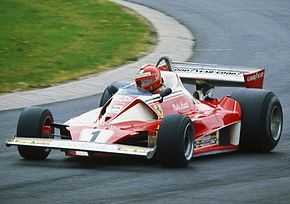
In 1970, a new car and engine was produced for that season, the 312B. It had an all-new Flat-12 engine, which was to be the engine used by the team for the next 10 seasons. Jacky Ickx rejoined the team and won the Austrian Grand Prix, the Canadian Grand Prix and the Mexican Grand Prix to become second in the Drivers' Championship. Clay Regazzoni made his debut that season and won the Italian Grand Prix, finishing third in the standings. Ferrari driver Pedro Rodríguez was killed in an Interserie sports car race at Norisring in Nuremberg, Germany, on 11 July 1971, at the wheel of a Ferrari 512M.
After three poor years, including a disastrous 1973 season which saw Ferrari failing to attend two races – the Dutch and German Grands Prix – for the first time since the team had started racing in Formula One, Ferrari signed Niki Lauda in 1974, and made the momentous decision to pull out of sportscar racing to concentrate upon F1. The same year Luca di Montezemolo was appointed Team Principal. Ferrari won Spanish Grand Prix, Dutch Grand Prix and German Grand Prix, but Regazzoni lost the World Championship to Emerson Fittipaldi at the final race of the season, the United States Grand Prix.
The new Ferrari 312T, developed fully with Lauda and Regazzoni and designed by Mauro Forghieri, was introduced in 1975, and brought the team back to winning ways, Lauda won five races and took the drivers' crown, and Ferrari won the Constructors' Championship.
In 1976 Lauda was comfortably leading the championship when he crashed at the German Grand Prix, seriously injuring himself. Carlos Reutemann was hired as a replacement, and Ferrari fielded three cars in the 1976 Italian Grand Prix when Lauda returned unexpectedly soon (only six weeks after his accident). Lauda scored points in the races following his severe crash, but voluntarily withdrew from the season-ending Grand Prix at Fuji after two laps because of heavy rain, and James Hunt won the title by a single point.
In 1977 Lauda, having come back from his near fatal crash the previous year, took the title again for Ferrari (and the team won the Constructors' Championship), overcoming his more fancied, and favoured, team mate Reutemann. His relations with the team, especially Forghieri, continued to deteriorate, and he decided finally to leave for Brabham at the end of the season.
In 1978, Ferrari raced with Reutemann and Gilles Villeneuve, and while they managed to produce a solid car, winning five races, it was outclassed by the ground effect Lotus 79.
Jody Scheckter replacing the Lotus bound Argentinian in 1979, took the title, supported by Gilles Villeneuve (who dutifully followed the South African home at Monza), and won the last World Drivers' Championship in a Ferrari until Michael Schumacher twenty one years later. The car was a compromise ground effect design due to the configuration of the Ferrari wide angle Flat-12, which was overtaken in due course by the extremely successful Williams FW07, but not before racking up the necessary points to take both titles that year.
1980s
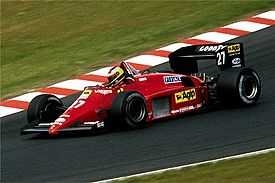
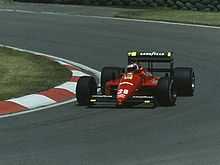
Ferrari and Jody Scheckter's 1980 title defence was unsuccessful, as the team's rivals made up ground at the expense of the reigning champions. The team scored a meagre total of eight points all season, and Scheckter elected to retire at its conclusion. For the 1981 season, Ferrari signed Didier Pironi to partner Gilles Villeneuve and also introduced its own turbo-charged engine, which provided more power in a more compact design than the previous normally aspirated, twelve-cylinder arrangement. The season was a distinct improvement on the last, Villeneuve winning the Monaco and Spanish Grands Prix, but a potential championship challenge was stymied by the difficult handling of the chassis. However, the lessons learnt from the team's first racing experience with a turbo car in F1 prepared it well for 1982. Throughout this season, the Ferrari was the best package, in terms of a balance between speed and reliability.
The year was, however, marred by the loss of both of Ferrari's drivers. Team leader and favorite driver of Enzo Ferrari, Villeneuve, died in a crash during qualifying at the Belgian Grand Prix, while Pironi suffered career-ending injuries before the German Grand Prix later in the season. Ferrari first called up Patrick Tambay, in place of the late Villeneuve, and later Mario Andretti in an effort to protect Pironi's lead in the championship, but to no avail. Ferrari did, however, win the Constructors' Championship. In that same year the Formula One works moved partially out of the original Maranello factory into its own autonomous facility, still in Maranello but directly next to the Fiorano test circuit.
Four wins by René Arnoux and Patrick Tambay won the team another constructors' title in 1983, but neither driver was consistent enough to challenge for the drivers' title. Patrick Tambay took an especially emotional victory at San Marino in front of the Tifosi, but left to join the Renault team at the end of the season. Michele Alboreto was hired for 1984 following his impressive performances during previous year driving a Cosworth-powered Tyrrell. He won the Belgian Grand Prix, but the team's performance was not competitive enough to challenge the dominant McLarens of Niki Lauda and Alain Prost. In the following year, however, Alboreto was Prost's closest challenger for the championship, leading it at one stage before the team's competitiveness slumped in the final races. Arnoux, meanwhile, fell out with the team and was replaced by Stefan Johansson after the first race of the season. 1986 continued the disappointing trend of the previous season as neither Alboreto nor Johansson could win a race, and never looked like doing so. For 1987, Johansson moved to McLaren and was replaced by Gerhard Berger, who got the better of Alboreto as the season progressed and won the final two races of the championship as the car's form improved towards the end of the season. The team remained competitive into 1988, finishing second in the Constructors' Championship, but a long way behind McLaren, who once again dominated the season.
The 1988 season also witnessed the end of Enzo Ferrari's ownership of the team. On 14 August 1988, Enzo died at the age of 90. Fiat's share of the company was raised to 90% with Enzo's only remaining son, Piero Ferrari, inheriting the remaining share from his father. A week after Enzo's death, Berger and Alboreto completed an historic 1–2 at the Italian Grand Prix, the only time a team other than McLaren won a Grand Prix in the 1988 season. Berger dedicated the win in memory of the late Enzo Ferrari.
1989 saw the end of turbo-charging in Formula One. From this date, the formula was for 3.5 litre normally aspirated engines of no greater than 12 cylinders, which was a direct consequence of lobbying by Ferrari for the previous few years. The team went so far as to construct an Indycar, the Ferrari 637, as a threat to the FIA that if they did not get what they wanted, namely the allowance of V12 engines under the revised formula, they could take part in another series. Due to the expected extreme high revs and consequent narrow power band expected of the new engines, technical director John Barnard insisted upon the development of a revolutionary new gear-shifting arrangement – the paddle-operated, semi-automatic gearbox. In pre season testing, the experimental system proved extremely troublesome, with newly arrived driver Nigel Mansell being unable to compete more than a handful of laps, but nonetheless they managed a debut win at the opening round in Brazil. Horrendous unreliability led to Berger being unable to score a point until a run of podiums at Monza, Estoril and Jerez including a win at Estoril. Mansell scored a memorable win at Budapest where he overtook world champion Ayrton Senna for the win after qualifying far down the field in twelfth. He then dedicated the race to the memory of Enzo Ferrari as the win came a year after the latter's death.
1990s
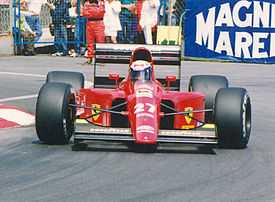

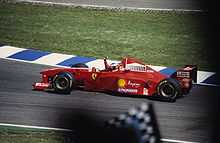
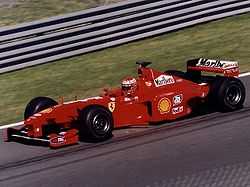
The 1990s started in a promising way. Alain Prost replaced Gerhard Berger at Ferrari to partner Mansell for the season. As reigning world champion, Prost took over as the team's lead driver and was said to have played on Mansell's inferiority complex. Mansell recalls one incident where at the 1990 British Grand Prix, the car he drove did not handle the same as in the previous race where had taken pole position, and later found out from team mechanics that Prost saw Mansell as having a superior car and had them swapped without Mansell knowing.[16] Prost won 5 races and pushed Ayrton Senna to the controversial penultimate race in Japan, where a collision forced him to settle for second. A disgruntled Mansell left the team at the end of the season.
Mansell's replacement was Frenchman Jean Alesi, who had been impressive during the previous two years at Tyrrell. However, Ferrari had entered a downturn in 1991, partially as their famous V12 engine was no longer competitive against the smaller, lighter and more fuel efficient V10s of their competitors. Prost won no races, only getting onto the podium five times. He afterwards publicly criticized the team, described his car as harder to drive than "a truck",[17] and was fired prior to the end of the season, right before the Australian Grand Prix.[18] Prost was replaced by Italian Gianni Morbidelli. The team won no races in 1991–1993.
Popular driver Gerhard Berger returned to Ferrari in 1993 to help it out of the doldrums. That year, Berger was instrumental in hiring Jean Todt as team principal, laying the foundations for the team's future successes. With the Ferrari 412T, Gerhard Berger and Jean Alesi proved the car's competitiveness throughout the two seasons, with a brace of podium places and four pole positions. Bad luck limited the number of wins to one each for both Berger (1994 German Grand Prix) and Alesi (1995 Canadian Grand Prix), particularly Alesi who was in a position to win at Monza and the Nürburgring in 1995, but the car was a solid and competitive proposition. Berger's win, achieved after three seasons without any triumph in a race, set a record of at least one victory in a season during the following twenty consecutive seasons.
In 1996, Ferrari made one of the most influential decisions in its history by hiring two-time defending world champion Michael Schumacher for the salary of around $30 million a year. Schumacher also brought with him the nucleus of his hugely successful Benetton team, mainly in the form of Ross Brawn (technical director) and Rory Byrne (chief designer). Teaming up with Jean Todt (team principal), they set about rebuilding the Scuderia. After Berger and Alesi, who were sent to Benetton in exchange, the traditional V12 had to go also, in favour of a more modern V10 engine, as the rules reduced the capacity from 3500 cc to 3000 anyway. At the same time, Eddie Irvine from Jordan was hired.
While these huge changes resulted in a very unreliable car, Schumacher did manage to score 3 wins in the 1996 season, all of which were memorable. In torrential conditions at Spain, after almost stalling and dropping to ninth, Schumacher went on to win the race by a comfortable margin to Jean Alesi. Following this, Ferrari had 2 incredibly embarrassing retirements at France and Canada, both before the races had even started. However, at Spa-Francorchamps Schumacher used right timed pit-stops to fend off the Williams of Jacques Villeneuve. Following that, at Monza, Schumacher scored a momentous win in front of the tifosi. As reliability greatly improved the Ferrari became the second strongest looking package in the hands of Schumacher ending with a strong fight with the Williams of champion Damon Hill for the win at Suzuka.
For 1997, the increased reliability of the previous year's development, the F310B, led to some very strong performances when faster cars, notably the Williams-Renaults of Heinz-Harald Frentzen and Jacques Villeneuve, retired. Schumacher took memorable wet weather wins at Monaco and Belgium, combined with outstanding drives at France and Japan, to force the Williams of Jacques Villeneuve to a last round title fight. However, Schumacher was disqualified from the 1997 standings for swerving into the car of Villeneuve who attempted to pass him down the inside of the Dry Sac corner of the Jerez circuit.
Following the dramatic 1997 season, Ferrari came out with an all new car to fit the new regulations for 1998. Although it was a competitive package, the McLaren–Mercedes MP4/13 was most often stronger. Schumacher won six races that season including three in a row at Canada, France and Great Britain. The Hungarian Grand Prix was won after a tactical master-stroke by Brawn decided to make the car run a 3-stop strategy as opposed to McLaren's 2. Schumacher then went on to lead Irvine home to Ferrari's first 1–2 at Monza since the memorable 1988 race after Enzo Ferrari's death. Schumacher lost the title to McLaren's Mika Häkkinen at Suzuka after he stalled on the front row then suffered a mid-race puncture. Irvine was fourth in the championship with Ferrari second in the constructors' title.
Irvine had been forced to play second fiddle to Schumacher, losing out on points and positions in order to place Schumacher higher in the Drivers' Championship, in the rare occasions when he was in front, notably Suzuka 1997 which led critics to remark "So Irvine can drive!". The leg injury of Michael Schumacher in 1999 reversed the roles however. It appeared to be the year Ferrari would regain the championship with Ferrari winning 3 of the first 4 races of the season. While Ferrari did win the constructors' crown that year, a crash at the Silverstone Circuit in the British Grand Prix resulted in Schumacher breaking a leg and missing 7 races of the season, and being replaced by Mika Salo. The new championship challenger was Eddie Irvine, who once again took the Ferrari challenge to the final round in Japan before missing out to Häkkinen who also scored more points in the races where Schumacher had taken part.
2000s
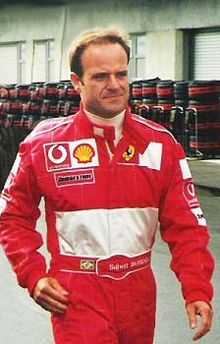
In 2000 Schumacher had a close battle with rival Mika Häkkinen of McLaren but won the championship in the Ferrari F1-2000, winning 9 races out of 17 that year. He was Ferrari's first World Driver's Champion in 21 years, since Jody Scheckter in 1979. Teammate Rubens Barrichello finished fourth in the championship, taking his maiden win at the German Grand Prix at Hockenheim after Schumacher was taken out in the first corner and Barrichello qualified 18th.
In 2001 Schumacher won the World Championship with four races to go, having claimed nine victories. Teammate Barrichello finished third in the championship. This was the first year in which the notorious A1-Ring incident occurred, where Barrichello was told to let Schumacher through for second place by team boss Todt, to the consternation of the FIA, fans and media.
In 2002, Schumacher and Barrichello dominated F1, the Ferrari duo winning 15 out of 17 races (Schumacher 11, Barrichello 4). However, their run was tainted by a second A1-Ring incident. In a replay of 2001, Barrichello was asked to give way to Schumacher, except this time for the win. An embarrassed Schumacher then pushed Barrichello to the top step of the podium, and was subsequently fined $1 million by the FIA for interfering with podium procedures. This debacle eventually led to the banning of team orders. Schumacher matched Juan Manuel Fangio's record of five world championships, set back in the 1950s.
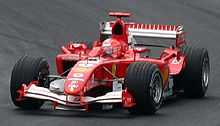
In 2003, Ferrari's domination of F1 was brought to a halt at the first race, the Australian Grand Prix, where for the first time in 3 years, there was no Ferrari driver on the podium. Rivals McLaren had an early lead in the championship, but Ferrari closed the gap by the Canadian Grand Prix. The Drivers' Championship went down to the last race, the Japanese Grand Prix, between Kimi Räikkönen (McLaren) and Michael Schumacher; Schumacher won the championship by two points, surpassing Fangio's record. In 2003, F1 magazine reported that Ferrari's budget was $443,800,000.[19]
2004 saw a return of Ferrari's dominance. Ferrari teammates Schumacher and Barrichello finished first and second respectively in the Drivers' Championship, and Ferrari easily wrapped up the Constructors' Championship. Schumacher won 13 of the 18 races, and 12 of the first 13 of the season – both F1 records. Barrichello won two of the other races.
2005 saw a change of fortune for Ferrari. The team started the year with the F2004M, a modified version of the previous year's car pending full development of their new car (F2005), the introduction of which was scheduled to be race 5 in Barcelona. The car lacked pace in comparison with other teams (particularly McLaren and Renault who started the year with brand new cars). Alarmed by poor performances in Australia and Malaysia the new F2005 was rushed into service in round 3 at Bahrain. This move saw Schumacher retire for the first time due to mechanical failure since Hockenheim 2001 ending a run of 58 Grands Prix without technical failure.
The poor relative performance of the team's Bridgestone tyres was also cited as a reason for Ferrari's lack of performance in 2005. The Bridgestone tyres failed to give sufficient grip in qualifying and were not as durable as their Michelin rivals during races. However, the tyres provided for the San Marino Grand Prix were more competitive, and the Bridgestone tyres supplied for the United States Grand Prix allowed the three Bridgestone teams to race, while the seven Michelin teams were forced to withdraw.
Near the end of the 2005 season, Rubens Barrichello announced that he was leaving the team at the end of the year and joining the Honda F1 team. Barrichello's departure was mostly due to his dissatisfaction with his continued "number two" status at Ferrari to Michael Schumacher. Ferrari named then Sauber driver Felipe Massa as Barrichello's replacement for the following season.
Ferrari's 2006 car, the 248 F1, was the first car developed entirely under Aldo Costa, after the departure of Rory Byrne.[20] Ferrari finished one-two in the United States Grand Prix. Massa won his first race at the Turkish Grand Prix, and Schumacher announced his retirement at the Italian Grand Prix, which he won. Kimi Räikkönen was announced as Schumacher's replacement for the 2007 season.[20] Still in contention for the championship, Schumacher won his final race at the Chinese Grand Prix, but ultimately fell short of an eighth drivers title.[20] At the Brazilian Grand Prix Schumacher finished fourth in his final race for Ferrari, setting the fastest lap following a puncture, the race was won by Massa. Ferrari finished five points behind Renault for the Constructors' Championship.[20]



In the F2007 Kimi Räikkönen won the inaugural race of the 2007 season, the first Ferrari driver to win on his début since Nigel Mansell in 1989. Räikkönen subsequently won the Drivers' Championship, and with nine victories Ferrari won the Constructors' Championship.
The 2007 Formula One espionage controversy directly concerned Ferrari, their employee, Nigel Stepney was dismissed by the team as a result.[21] The case revolved around the theft of technical information.[22]
After the end of the 2007 season, Ferrari President Luca Cordero di Montezemolo announced a new structure for the team, with Jean Todt departing the team principal role and moving up to his senior role as CEO of the company, Stefano Domenicali took over as team principal as Ross Brawn declined a return following his sabbatical (he became Team Principal of Honda F1), Aldo Costa as technical director and Mario Almondo as Operations Director.[23] It had been reported that this completed a shift in Ferrari personnel where the older foreign leadership was replaced with a new one composed mostly of Italians.[24]
The F2008 was Ferrari's car for the 2008 season; Räikkönen and Massa scored a one-two early in the season at the Bahrain Grand Prix. Massa won his third successive Turkish Grand Prix, and battled McLaren's Lewis Hamilton for the Drivers' Championship. Massa went into the final race of the season, the Brazilian Grand Prix, in contention for the championship. Massa won the race, but ultimately lost the championship to Hamilton. In October 2008 Ferrari issued a statement saying that they would review their participation in Formula One at the end of the 2009 season, due to the FIA's desire to introduce standardised engines. The FIA's plan was never implemented.
Ferrari started the 2009 season poorly with their F60 car, outperformed by Red Bull Racing and Brawn GP. At the Hungarian Grand Prix Massa was knocked unconscious in an accident in qualifying, he was replaced by Luca Badoer and Giancarlo Fisichella successively.
2010s
.jpg)
Despite still having a year of his contract remaining Räikkönen left Ferrari and was replaced by the double world champion Fernando Alonso.[25]
The 2010 season started with Fernando Alonso leading a Ferrari 1–2, with Massa second, at the 2010 Bahrain Grand Prix. However, after seven races Ferrari were lying third in the Constructors' Championship, following a string of low points finishes. After the 2010 German Grand Prix at Hockenheim, Ferrari remained third in the Constructors' Championship following a controversial 1–2 finish, where leader Felipe Massa was seemingly asked by the team to give the position to Fernando Alonso. The enforced and deliberate swapping of places reminded many fans of the 2002 incident where Rubens Barrichello was asked to cede the lead of the Austrian Grand Prix to eventual winner Michael Schumacher, who invited Barrichello onto the first-place spot on the podium after gauging the spectators reaction, trying to soften the blow of the final result. That incident led to a ban on team orders. Thus, the Stewards deemed Ferrari to be in breach of both that regulation and guilty of bringing the sport into disrepute, fining the team $100,000 – the maximum penalty race stewards can impose. The incident was also referred to the FIA World Motor Sport Council for review. Alonso won further races at Monza, Singapore and the inaugural race in Korea as he finished the season as runner-up to Sebastian Vettel.
In 2009 Ferrari announced that Felipe Massa would continue to partner Fernando Alonso until at least the end of the 2012 season.[26] Ferrari launched its 2011 car, the Ferrari 150° Italia in January 2011, with Ford declaring intentions to sue over the use of the F150 name – under which the car had been launched – Ferrari began referring to the car as the "F150th Italia".[27] In March 2011, the car's name was changed again to "150º Italia", with the Italian language ordinal indicator º being used to replace the English language -th.[28] Ford and Ferrari also settled their legal matter, asking for the case to be dismissed at a court in Detroit.[29]
The 2012 season saw Ferrari continue with the driver pairing of the previous two years of Fernando Alonso and Felipe Massa,[26][30] with Alonso once again narrowly missing out on the drivers' title.
In 2011 Alonso renewed his contract with Ferrari to at least the end of the 2016 season.[31] Massa renewed his contract for one more season alongside Alonso.[32] Ferrari's car for the 2013 Formula One season is the Ferrari F138. Massa was replaced by Kimi Räikkönen for 2014, while Alonso was retained. Despite having such a lineup, the team struggled throughout the season, only achieving two podiums and finishing fourth in the Constructors' Championship behind a resurgent Williams, marking Ferrari's first winless season since 1993. Stefano Domenicali was replaced as team principal by Marco Mattiacci. Prior to the 2014 Italian Grand Prix, Luca Cordero di Montezemolo announced his resignation as Ferrari chairman. Räikkönen was retained for the 2015 season while Alonso left the team, to rejoin McLaren. He was replaced by Sebastian Vettel, who left Red Bull Racing.[33]
After a massive overhaul in terms of management, with Sergio Marchionne and Maurizio Arrivabene replacing di Montezemolo and Mattiacci respectively, and driver lineup, the team enjoyed an improved start to the 2015 season with Vettel taking third in Australia. However, Raikkonen was forced to retire from the race due to a loose wheel. The team ended their 34-race winless streak in Malaysia when Vettel held off both Mercedes cars to claim his first victory since leaving Red Bull.
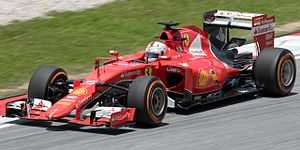
Engine supply
Ferrari has always produced engines for its own Formula One cars, and has also supplied engines to other teams. In 2013 the Scuderia Toro Rosso and Sauber teams used Ferrari engines. It has previously supplied engines to Minardi (1991), Scuderia Italia SpA (1992–1993), Sauber (1997–2005 with engines badged as 'Petronas' and 2010–2013), Prost Grand Prix (2001, engines badged 'Acer'), Red Bull Racing (2006), Spyker F1 (2007), Force India (2008).
In 2014, when Cosworth decided not to make the new V6 turbo engines, Marussia, the only team that used Cosworth, signed a multi-year deal with Ferrari, starting 2014. So, in 2014, Ferrari supplies 3 teams – Ferrari, Sauber and Marussia. In 2014 Ferrari "had the worst engine in 2014".[34] Starting in 2016, Ferrari will supply the new Haas F1 Team.[35]
Relationship with governing body
Ferrari did not enter the first ever race of the championship, the 1950 British Grand Prix due to a dispute with the organisers over "start money". In the 1960s Ferrari withdrew from several races in 'strike' actions.
In latter years, Scuderia Ferrari has gained a unique place in Formula One as one of the most popular and historic teams, which the team have often exploited in negotiating with the sports governing body.
In 1987, Ferrari considered abandoning Formula One for the American IndyCar series. This threat was used as a bargaining tool with the FIA – Enzo Ferrari offered to cancel the IndyCar Project and commit to Formula One on the condition that the technical regulations were not changed to exclude V12 engines. The FIA agreed to this, and the IndyCar project was shelved, although a car, the Ferrari 637 had already been constructed.
In 2009 it emerged that Ferrari had an FIA-sanctioned veto on the technical regulations.
Team orders controversies
Team orders have proven controversial at several points in Ferrari's history.
In 1982, at the San Marino Grand Prix, the two Ferraris were leading with Gilles Villeneuve ahead of Didier Pironi. The team gave an order for the cars to slow down to reduce the risk to the cars, which was apparently interpreted differently by the two drivers. Villeneuve was angered when Pironi overtook and won the race. Villeneuve's anger at what he saw as betrayal by his team mate is often considered to have been a contributory factor to his fatal accident in qualifying at the next race, the 1982 Belgian Grand Prix.
Throughout Michael Schumacher's time at Ferrari, he was given preferential treatment over his team mates (Eddie Irvine, Rubens Barrichello and Felipe Massa). This strategy was often unpopular with fans of the sport and the rival teams, and came to a head at the 2002 Austrian Grand Prix, at which Barrichello who had led almost the entire race was ordered to give way to Schumacher, which he did at the last corner of the final lap. This was a particularly unpopular move, as it occurred at an early stage in the season, when both drivers had a chance to win the Drivers' Championship.
At the 2010 German Grand Prix, Ferrari informed Massa that Fernando Alonso was quicker than him, and after two repeats of this information, Massa allowed Alonso to pass him. This exchange of information has widely been interpreted as a team order for Massa to allow Alonso to pass him. The result led to Alonso winning, with Massa finishing second and Sebastian Vettel taking the final place on the podium. Ferrari were fined the maximum penalty available to the stewards, $100,000, for breach of regulations and for bringing the sport into disrepute. Ferrari said they would not contest the fine. The team were referred to the FIA World Motor Sport Council, where the Council upheld the view of the stewards, but did not take any further action.[36][37]
F1 team sponsorship
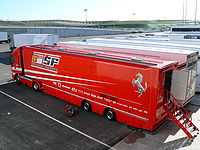
The Ferrari Formula One team was resistant to sponsorship for many years and it was not until 1977 that the cars began to feature the logo of the Fiat group (which had been the owners of the Ferrari company since 1969). Until the 1980s, the only other companies whose logos appeared on Ferrari's F1 cars were technical partners such as Magneti Marelli, Brembo and Agip.
In 1996 Philip Morris International withdrew its sponsorship agreement with McLaren after 22 years to become title sponsor of Ferrari. In September 2005 Ferrari signed an extension of the arrangement until 2011 at a time when advertising of tobacco sponsorship has become illegal in the European Union and other major teams have withdrawn from relationships with tobacco companies – McLaren had ended its eight-year relationship with West. In reporting the deal, F1 Racing magazine judged it to be a 'black day' for the sport, putting non-tobacco funded teams at a disadvantage and discouraging other brands from entering a sport still associated with tobacco. The magazine estimated that in the period between 2005 and 2011 Ferrari received $1 billion from the agreement. The last time Ferrari ran visible tobacco sponsorship on the car was in the 2007 Chinese Grand Prix, with barcodes and other subliminal markers afterwards. On 8 July 2011, it was announced that the 'Marlboro' section of its official team name had been removed from the British Grand Prix onwards, following complaints from sponsorship regulators. The team is now called 'Scuderia Ferrari'.[38]
In December 2005 Vodafone announced that it was withdrawing its sponsorship of Ferrari in favour of title sponsorship of McLaren beginning in 2007. The Times said Ferrari was "stunned" by the decision.[39] Vodafone's position on the car has been taken over by Telecom Italia's broadband Alice brand.
On 10 September 2009, Ferrari announced that it would be sponsored by Santander from 2010 on a five-year contract.[40] It is believed that Santander will pay around €40 million ($56.5 million, £35 million) per season to sponsor Ferrari. The contract was subsequently extended to end in late 2017.[41]
As part of the deal with Acer, it is allowed to sell Ferrari-badged laptops. On the other hand, in early 2009 semiconductor chip maker AMD announced it had decided to drop its sponsorship of the team and is just waiting for its contract to expire after its former Vice President and Sales Executive (who was an avid fan of motorsports) had left the company.[42]
On 3 July 2014 Ferrari announced a two year sponsorship agreement with the United States based Haas Automation tool company which will transfer into a powertrain deal in 2016 when the Haas F1 Team enters the sport.[43]
The companies currently sponsoring Scuderia Ferrari include Alfa Romeo, Philip Morris International, Santander, Shell, Hublot, TNT Energy Drink, Kaspersky Lab, Weichai Power and UPS.[44]
The official suppliers of Ferrari include Puma, Magneti Marelli, OMR, SKF, Iveco, NGK, Brembo, Mahle GmbH and Oakley, Inc..[44] Other suppliers include Bell Sports, Honeywell, OZ Group and Technogym.[44]
Formula One results
- Constructors' Championships winning percentage: 28.1%
- Drivers' Championships winning percentage: 23.1%
- Winning percentage: 24.8%
The Ferrari team has achieved unparalleled success in Formula One and holds many significant records including:
- Most Constructors' Championships: 16
- Most Drivers' Championships: 15
- Most Grands Prix participated (all-time): 894
- Most Grands Prix started (all-time): 892[5]
- Most wins (all-time): 222[6]
- Most podiums (all-time): 683
- Most one-two finishes (all-time): 81
- Most one-two finishes with the same drivers (Michael Schumacher – Rubens Barrichello): 24
- Most pole positions (all-time): 207
- Most WCC points (all-time): 5,941.5
- Most WDC points (all-time): 6,843.27
- Most fastest laps (all-time): 231
- Most consecutive seasons with at least one victory during a season: 20 (1994–2013)
Ferrari is also the most successful F1 engine manufacturer, with 223 wins. Of the 19 tracks used in 2014, 8 have lap records set by the Ferrari F2004, with a further 3 set by the Ferrari F2003-GA, Ferrari F2008 and Ferrari F10.
Formula Two
Ferrari competed in the Formula 2 series in several years, as follows:
- 1948–51: 166 F2
- 1951–53: 500 F2
- 1953: 553 F2
- 1957–60: Dino 156 F2
- 1967–69: Dino 166 F2
Sportscar racing
From the late 1940s to the early 1970s, Ferrari competed in sports car racing with great success, winning the World Sportscar Championship 13 times. Ferrari scored early successes in sportcars, taking wins in the 1950 and 1951 Mille Miglia, although the 1951 victory resulted in a lengthy litigation when Ascari crashed through a barrier and killed a local doctor.
In 1953, the World Sportscar Championship was established, and Scuderia Ferrari along with other manufacturers such as Aston Martin, Mercedes-Benz, Jaguar began to enter multiple factory backed cars in races such as the Le Mans 24 Hours. Ferrari launched a large range of sports racers over the next three years. This included the traditional compact V12-powered 166 MM and 250 MM, the larger V12 290, 340, and 375 MM and 315, 335, and 410 S, the four-cylinder 500, 625, 750, and 860 Monzas, and the six-cylinder 118 and 121 LM. With this potent lineup, Ferrari was able to claim six of the first seven WSC titles: 1953, 1954, 1956, 1957, and 1958.
This sportscar championship included road races such as the Carrera Panamericana in Mexico, Mille Miglia in Italy and the Sicilian Targa Florio. Ferrari cars (including non-works entries) won the Mille Miglia eight times, the Targa Florio seven times, and the 24 hours of Le Mans nine times. Throughout the 1960s, Ferrari were a dominant force in sportscar racing, winning the 24 Hours of Le Mans 6 years in a row from 1960 to 1965.
With the introduction of the Sports Prototypes class, Ferrari developed the P series, but 1970s were to be the last decade Ferrari entered as a works effort in sports car racing. After an uninspired performance in the 1973 F1 World Championship, Enzo Ferrari stopped all development of sports cars in prototype and GT racing at the end of the year, in order to concentrate on Formula One.
Ferrari cars were raced in a range of classes such as GT Racing by other entrants, but not by the factory Scuderia Ferrari team. In the 1990s, Ferrari returned to Sports prototypes as a constructor with the 333SP with enormously great success, although Scuderia Ferrari itself never raced this car.
See also
References
- ↑ "Welcome Sebastian – Vettel and Raikkonen 2015 driver pairing". Ferrari (Ferrari). 20 November 2014. Retrieved 20 November 2014.
- ↑ "Official: Raikkonen seals Ferrari return". GPUpdate (GPUpdate). 11 September 2013. Retrieved 11 September 2013.
- ↑ "A Mexican driver is back to Maranello". Ferrari (Ferrari). 15 December 2014. Retrieved 15 December 2014.
- ↑ "Jean-Eric Vergne becomes test driver for the Scuderia". Ferrari (Ferrari). 19 December 2014. Retrieved 19 December 2014.
- ↑ 5.0 5.1 Includes NART entries. Doesn't include Peter Whitehead's private entry in 1950 French Grand Prix.
- ↑ 6.0 6.1 Includes Giancarlo Baghetti's win in the 1961 French Grand Prix in a privately entered Ferrari.
- ↑ This is the number of different World Championship races in which a Ferrari car has set the fastest lap time. In both the 1954 British Grand Prix and 1970 Austrian Grand Prix, two drivers each set equal fastest lap time in Ferraris. This number includes Giancarlo Baghetti's fastest lap in the 1961 Italian Grand Prix in a privately entered Ferrari.
- ↑ "Kimi Räikkönen". Scuderia Ferrari. Retrieved 19 April 2015.
- ↑ "Sebastian Vettel". Scuderia Ferrari. Retrieved 19 April 2015.
- ↑ "The Scuderia Ferrari has been reorganized". 2014-12-16.
- ↑ Henry, Alan (1989). Ferrari – The Grand Prix Cars (2nd ed.). Hazleton. p. 12.
- ↑ Henry, Alan (1989). Ferrari – The Grand Prix Cars (2nd ed.). Hazleton. p. 13.
- ↑ scuderia – Dizionario italiano-inglese WordReference. Wordreference.com. Retrieved on 2013-08-16.
- ↑ James Allen (22 May 2009). "The scene in Monaco". www.jamesallenonf1.com/. Retrieved 25 February 2010.
- ↑ Henry, Alan (1989). Ferrari – The Grand Prix Cars (2nd ed.). Hazleton. p. 340.
- ↑ Mansell, Nigel My Autobiography page 222 Collins Willow ISBN 0-00-218497-4
- ↑ Zapelloni, Umberto (April 2004). Formula Ferrari. Hodder & Stoughton. p. 17.
- ↑ Murray Walker & Simon Taylor, Murray Walker's Formula One Heroes p. 115, lines 6–9. Virgin Books, ISBN 1-85227-918-4
- ↑ Katinger, Josh (28 February 2004). "The Price of Formula 1". Archived from the original on 2011-09-20. Retrieved 9 April 2007.
- ↑ 20.0 20.1 20.2 20.3 "New National Museum of Monaco". 2006 team review — Ferrari. Formula One. Retrieved 18 July 2013.
- ↑ "Stepney dismissed by Ferrari". Autosport. 3 July 2007. Retrieved 3 July 2007.
- ↑ Noble, Jonathan; Goren, Biranit (3 July 2007). "Ferrari confirm action against McLaren man". Autosport (Haymarket). Retrieved 3 July 2007.
- ↑ Autosport Article: Ferrari Announce Change in tech structure
- ↑ "Todt replaced as Ferrari boss". news.bbc.co.uk. 12 November 2007. Retrieved 12 November 2007.
- ↑ "Raikkonen set for Formula One sabbatical in 2010". Formula1.com (Formula One Administration). 18 November 2009. Retrieved 7 December 2012.
- ↑ 26.0 26.1 "Felipe Massa to stay at Ferrari until 2012". Formula1.com (Formula One Administration). 9 June 2009. Retrieved 7 December 2012.
- ↑ "The name of the new Ferrari Formula 1 car". Scuderia Ferrari (Ferrari). 10 February 2011. Archived from the original on 2014-09-04. Retrieved 10 February 2011.
- ↑ "The Horse Whisperer – The name changes but not the sense". Scuderia Ferrari (Ferrari S.p.A.). 4 March 2011. Archived from the original on 2013-11-05. Retrieved 6 March 2011.
- ↑ Noble, Jonathan (4 March 2011). "Ford settles name dispute with Ferrari". Autosport (Haymarket Publications). Retrieved 6 March 2011.
- ↑ "Alonso to replace Raikkonen at Ferrari in 2010". Formula1.com (Formula One Administration). 30 September 2009. Retrieved 7 December 2012.
- ↑ "Fernando Alonso to stay at Ferrari until 2016". Formula1.com (Formula One Administration). 19 May 2011. Retrieved 7 December 2012.
- ↑ "Massa to stay at Ferrari for 2013". Formula1.com (Formula One Administration). 16 October 2012. Retrieved 7 December 2012.
- ↑ "Sebastian Vettel: German joins Ferrari as Fernando Alonso exits". BBC Sport. 20 November 2014. Retrieved 20 November 2014.
- ↑ Benson, Andrew (16 January 2015). "Honda wins Formula 1 engine battle with FIA". BBC Sport (BBC). Retrieved 17 January 2015.
- ↑ "Haas F1 Team seals multi-year Ferrari engine deal from 2016". Autosport (Haymarket Publications). 3 September 2014. Retrieved 17 January 2015.
- ↑ "Ferrari escape further punishment". Planet F1 (365 Media Group Ltd.). 8 September 2010. Retrieved 8 September 2010.
- ↑ Collantine, Keith (8 September 2010). "Ferrari escape further punishment for German GP team orders (Updated)". F1 Fanatic (Keith Collantine). Retrieved 8 September 2010.
- ↑ Cooper, Adam (8 July 2011). "Ferrari Drops Marlboro From Team Name". speedtv.com (Speed). Archived from the original on 2013-03-01. Retrieved 8 July 2011.
- ↑ Eason, Kevin; O'Connor, Ashling (15 December 2005). "Ferrari left stunned by Vodafone defection". The Times (Times Newspapers). p. 77. Retrieved 9 April 2007.
- ↑ "Ferrari seals five-year Santander deal". ITV. 10 September 2009. Archived from the original on 2009-09-15. Retrieved 10 September 2009.
- ↑ Cushnan, David (3 February 2012). "Santander extends with Ferrari until 2017". Retrieved 18 April 2015.
- ↑ "AMD drops Ferrari F1 sponsorship". fudzilla.com. Retrieved 11 January 2009.
- ↑ Cooper, Adam (3 June 2014). "HAAS AUTOMATION PARTNERS WITH FERRARI F1 TEAM". Foxsports.com. Retrieved 3 June 2014.
- ↑ 44.0 44.1 44.2 "Partners". Scuderia Ferrari. Retrieved 31 January 2015.
External links
| Wikimedia Commons has media related to Scuderia Ferrari. |
Ferrari's facilities at Maranello with Fiorano test track are at coordinates 44°31′59″N 10°51′47″E / 44.533124°N 10.863097°E
| Achievements | ||
|---|---|---|
| Preceded by Cooper |
Formula One Constructors' Champion 1961 |
Succeeded by BRM |
| Preceded by Lotus |
Formula One Constructors' Champion 1964 |
Succeeded by Lotus |
| Preceded by McLaren |
Formula One Constructors' Champion 1975–1976–1977 |
Succeeded by Lotus |
| Preceded by Lotus |
Formula One Constructors' Champion 1979 |
Succeeded by Williams |
| Preceded by Williams |
Formula One Constructors' Champion 1982–1983 |
Succeeded by McLaren |
| Preceded by McLaren |
Formula One Constructors' Champion 1999–2000–2001–2002–2003–2004 |
Succeeded by Renault |
| Preceded by Renault |
Formula One Constructors' Champion 2007–2008 |
Succeeded by Brawn |
| ||||||||||||||||||||||||||||||||||||
| ||||||||||||||||||